Home
What's New
Prismat
Fixed Lens
TL & DTL
XTL & X-1000
MSX & DSX
NC1000
Z-Series
Other Mamiya
Manuals
Related Links
Camera Prices
Lens Prices
Rest of
Collection
FAQ
Mamiya 35mm
Forum
How To

Your Donations
Help Fund This Site.
Thanks for Your
Continued Support!
|
Mamiya 35mm Rangefinder Information
Mamiya had already established
a rich 35mm rangefinder heritage before they began producing 35mm
SLR's. But good technical data is hard to find, and this information
is a long way from complete. New information any Gentle Reader might
have about these cameras will help make this site better and you are
actively encouraged to submit it! Please consider joining the
Collecting Mamiya 35mm Forum where you can
share any of the much-needed information! |
|

MAMIYA 35-I (c.1949) from the R.L. Herron Collection

MAMIYA 35-II, (c.1955) from the R.L. Herron collection. |
Mamiya
35-I and 35-II
Building on the success of the mid-size Mamiya-6
folder, which had quickly developed a reputation for reliability
and unique design, Mamiya built an equally unique 35mm model. It was the first
Japanese camera to automatically cock a leaf shutter as the film was wound.
The Mamiya 35-I, (c.1949), with a fixed 5cm f/3.5 Hexar lens
in a Copal B shutter, had speeds from 1 sec. to 1/200 and B. It featured
a knob-wind film advance, and also adopted the unique backfocusing
arrangement of the larger Mamiya-6, in which the lens did not move
during focusing. Instead, the entire film plane itself moved within
the camera, through the same ingenious mechanics that focused the
Mamiya-6. There were problems, however, keeping the film flat in the
35mm format and the back-focusing 35mm was abandoned.
The Mamiya 35-II, introduced in 1955, is immediately recognizable
from the similar Mamiya 35-I that preceded it by the change
in the distinctive round shape of the viewfinder window. The round
viewfinder would not appear again on Mamiya 35mm rangefinder cameras.
There were other noticeable differences, such as the squared-off top
plate and the knurled film advance and rewind knobs. The 35-II was
originally available with a f/3.5 lens (see picture at left), and
a faster f/2.8 lens was sold in 1956.
Remarkably sturdy cameras, both the Mamiya 35-I and
35-II can still occasionally be found today, although they are rare.
One in serviceable or repairable mechanical condition is becoming
extremely rare, with auction prices beginning to climb considerably.
These are both extremely sought-after items for true Mamiya collectors.

MAMIYA 35-I, showing the unique faceplate
that held the film flat
|
Mamiya
Mammy
The Mamiya Mammy, a low-priced camera with a
strangely-shaped bakelite body, is worth mentioning as part of Mamiya's
35mm heritage. Introduced in 1953, this "camera for the masses,"
featured front lens focusing and produced 24x28mm exposures on paper-backed,
unperforated 35mm film stock (828 film). The picture at right is my
only good image of the camera. It apparently sold very well in Japan.
However, I have been unable to find records to indicate how well it
was received -- or if it was even marketed -- in the rest of
the world. It is a very rare item today, and is seldom seen in auction.
|

MAMIYA MAMMY (c.1953) |
|

MAMIYA 35-III (c.1957) from the R.L.
Herron collection.

|
Mamiya 35-III
Another significant advance came in September 1957,
on the release of the Mamiya 35-III, (left). It was a helical
focus camera with a self-cocking lever and linked finder. It had
a flash mount shoe (cold), manually-set dials for film type and
shot counting (on the film advance).
Its lens is a fixed 5cm f/2.8 Mamiya-Sekor in a
Seikosha-MXL shutter (speeds from 1 sec. - 1/500 including B). Slightly
more expensive, a version with an f/2.0 lens in the same Seikosha
shutter was also available. Both versions are rare today.
 
ALSO
PICTURED from the R.L. Herron collection (above, left to right):
MAMIYA WIDE (c.1957)
Essentially a 35-III equipped with a 35mm lens
MAMIYA WIDE E (c.1959)
Improved Mamiya Wide with selenium meter

MAMIYA PROTOTYPE (c.1957)
Apparently a one-of-a-kind item, this prototype image,
identified as a Mamiya 35-2 prototype, was received
from Mamiya Japan
|
|
Mamiya Magazine 35
Introduced in April 1957, the fascinating Mamiya
Magazine 35 is one of the truly unique commercial cameras introduced
by Mamiya. Available for years in medium- and large-format cameras,
a 35mm interchangeable back had been found previously only in the
ultra expensive Kodak Ektra, which was introduced in 1939 and discontinued
less than a year later. The Adox 300 (c.1956) also had an interchangeable
35mm back but it, too, was short-lived, and there is no evidence
it was ever imported into the U.S. market. Thus, years ahead of
its time, the Mamiya Magazine 35 was the first mass-produced, mass-marketed
35mm format camera with a film-back interchange system.
Using a fixed 50mm f/2.8 Mamiya-Sekor lens in a Seikosha MXL shutter,
it has a fast-focusing parallel-action helical mount with 90º
sweep-lever throw for 3½ feet to infinity focusing. An f/2
lens was also available, but finding one is rare. The shutter boasts
nine speeds, from 1/500 to 1 sec. and B, and full flash synchronization.
It has a contrasty coupled rangefinder and the single window viewfinder
also provides a parallax indicator.
The magazine "Popular Photography," in its November 1957 edition,
called it "an intelligently designed" and highly dependable camera
"which combines optical and mechanical excellence." The camera was
not, however, as commercially successful as Mamiya, or the early
critics, had anticipated. In 1957 the Mamiya Magazine 35,
with one film magazine, sold for $89.50. Check my
Auction Prices tables for the current
auction average prices. A remarkably sturdy camera, with good optics,
it can still be found in auctions today, although finding one in good
working condition is becoming increasingly rare.
| 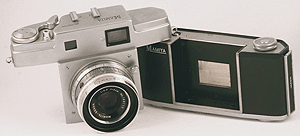
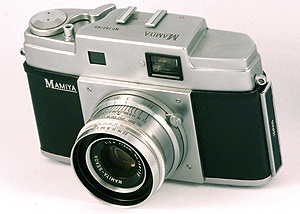
MAMIYA MAGAZINE 35 (c.1957) from the R.L. Herron collection.
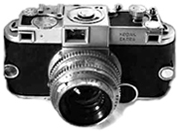 
Kodak EKTRA (left; c.1939) and Adox 300 (right; c.1956)
|
|
Mamiya Elca
The Mamiya Elca (right), was introduced
in April 1958, as Japan's first camera with match-needle metering. The
aperture, shutter and film speeds were connected by resistors, and the needle
was aligned against a fixed pointer. It had a coupled rangefinder with a
selenium meter. The exposure metering, shutter cocking and rangefinder setting
were operated simultaneously by the film advance lever.
It was furnished with a fixed 5cm (50mm) Mamiya-Sekor
f/2.8 lens in a Copal-Special-MXV shutter, with speeds from 1 - 1/500 and B. It
is one of the rarer Mamiya rangefinders today.
|
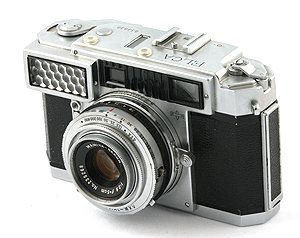
MAMIYA ELCA (c.1958) from the R.L. Herron
collection. |

MAMIYA 35 CROWN (c.1958) from the R.L. Herron collection.

|
Mamiya 35 Crown
The Mamiya 35 Crown (left), growing out of the
Mamiya 35-III, related to the Mamiya 35-S and S2, and one of several
sister cameras of the Mamiya Metra, was released in 1958. It featured
a self-cocking lever and linked finder, but had no exposure meter.
It was available with either a fixed f/1.9 or f/2.8 lens in a Seikosh-MXL
shutter. Notable for its grey body covering, it was also marketed
in some areas as the Mamiya Executive (some may have featured
black covering).
 
 
 
PICTURED ABOVE (left to
right, beginning at top):
MAMIYA METRA (c.1958)
MAMIYA CROWN (c.1958) A version of the Metra without an
exposure meter
MAMIYA AUTO METRA (c.1959)
MAMIYA AUTO METRA-2 (c.1959)
MAMIYA SKETCH (c.1959) Japan's first 24x24cm format with 35mm
film. A format that never became popular in either the Japanese or
export markets. It had first-class optics with a linked rangefinder,
and was finished in grey leather. It is EXTREMELY RARE in auction
today.
MAMIYA 35-S2 (c.1959); Similar to the MAMIYA 35-S, which
was released about the same time, the S2 was a coupled rangefinder
with a 48mm Mamiya-Sekor f/2.8 helical focus lens, in a Copal-SV 1-500
shutter |
|
Mamiya Ruby
In September 1959, Mamiya introduced another leaf
shutter 35mm camera, the Mamiya Ruby. It was a front-lens
focusing linked rangefinder with a point matching exposure meter,
read in a dial on top of the camera, not through the lens (see
picture at right). It had a 48mm f/2.8 Mamiya-Sekor lens. A
more advanced version, featuring lens and aperture control, with
an f/1.9 Mamiya-Sekor lens, was introduced in May 1960. The Ruby
was to become the style basis for several Mamiya rangefinders.

MAMIYA RUBY Meter
Building on the Ruby line was the Mamiya M3,
a less expensive cousin, introduced in May 1961. It featured a fully
synchro flash contact, shutter speeds from 1 to 1/500, and came
with a fixed 48mm Mamiya-Kominar f/2.0 lens. Yet another related
camera, the Mamiya 4B, released in 1963, came with a selenium-cell
meter, a fixed 40mm Mamiya-Kominar f/2.8 lens and a much more limited
shutter (1/4 - 1/250). Similar Mamiya rangefinders were often rebranded
as Rank Mamiya cameras when sold in the U.K.
|

MAMIYA RUBY (c.1960) from the R.L. Herron collection.


Above (left to right):
MAMIYA - M3 (c.1961); and MAMIYA - 4B (c.1963)
|
|
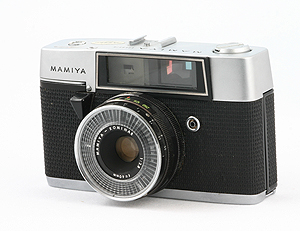
MAMIYA EE MERIT (c.Feb 1962) from
the R.L. Herron collection.

MAMIYA EE SUPER MERIT (c.Sept 1962)
from the R.L. Herron collection.
|
Mamiya EE Merit
Pictured at left is the Mamiya EE Merit, a lens
shutter 35mm rangefinder first released in February 1962. An advanced version,
the Mamiya EE Super Merit, was released in September of the same year.
Featuring shutter priority, focus in this coupled rangefinder is identified
by marks in the distance-linked viewfinder.
Both the EE Merit and Super Merit had a fixed 40mm
f/2.8 Mamiya-Kominar lens, an automatic shot counter and four shutter
speed settings: 1/30, 1/60, 1/125 and 1/250. The Super Merit is
distinguishable by a slightly wider, black-framed bezel around the
front rangefinder window. Both versions were also marketed by Honeywell
as the Honeywell Electric Eye 35. Yet another version was
sold as the Mansfield Eye-Tronic R. Mansfield was a division
of Argus, Inc.
There was another name variant, known as the Vulcan, but
until recently I had no information as to where this version was
marketed. Thanks to reader Maurice Fisher, it is confirmed that
the Mamiya Vulcan was a rebranded Mamiya EE Super Merit, sold in
the UK through the retailer Dixons.

MAMIYA VULCAN, shown in an advertisement
for UK retailer, Dixons,
September 1963. Ad image courtesy Maurice
Fisher. |
|
Mamiya Super Deluxe
The Mamiya Super Deluxe was released in August
1964. This leaf shutter 35mm had a point-matching exposure control
and an auto counter. It came with either a fixed Mamiya-Sekor 48mm
f/1.7 or a Mamiya Kominar f/2.0 lens -- both in a Copal-SVE shutter,
synched to either manual or electronic flash. In November 1964, a
version featuring an even faster f/1.5 Mamiya-Sekor lens was released.
Earliest versions have "Super Deluxe" on the front of the
top housing, below the meter cell (see picture, right). Later versions
have "Super Deluxe" in script letters, on the front left-hand
side of the camera body. All versions use a single 1.3v PX-675 mercury
battery (almost universally banned).
Battery Note:
You can find an acceptable zinc-air substitute for the 1.3v PX-675
mercury battery the Super Deluxe requires at
Vintage Batteries.com.
|

MAMIYA SUPER DELUXE 2.0 (c. 1964) from the R.L. Herron collection.

MAMIYA AUTO DELUXE (c. 1961)
from the R.L. Herron collection.
Another camera preceeding the
Super Deluxe was the Mamiya Auto-Deluxe (above, c.1961). It
had a coupled rangefinder with a match-needle selenium meter. Unlike
most 35mm designs from Mamiya, the Auto-Deluxe had the meter cell
at the left-hand side of the camera body. It was equipped with a 48mm
Mamiya-Sekor f/1.7 1-500 lens and a Seikosha-SLV shutter. A variant
of this camera was also sold branded as the Pro-Matic. |
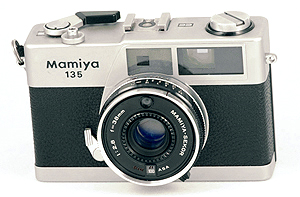
MAMIYA 135 EE (c.1977) from the R.L. Herron collection.

|
Mamiya 135
At left is the Mamiya 135 (c.1977), a programmed
EE camera with a linked rangefinder and flash charge lamp (for dedicated
flash). It has a fixed 38mm Mamiya-Sekor f/2.8 lens, a self-timer,
a hot shoe and a built-in light meter, read through the viewfinder.
Similar to many small 35mm rangefinders produced about this time
(the small
Rollei XF35, c.1974, or the
Minolta Hi-Matic F come to mind),
it used a 1.3v PX-675 mercury battery. Mercury batteries are now
banned in most countries (see Battery Note above).

MAMIYA MYRAPID (above; c.1965) An automatic
half-frame 35mm with a selenium cell surrounding the 32mm Tominon
f/1.7 lens in an Auto Copal 1/30 - 1/800 shutter. It produced an 18x24mm
image on Rapid-cassettes, which are no longer available. |
© R.L. Herron All
Rights Reserved. Legal
|